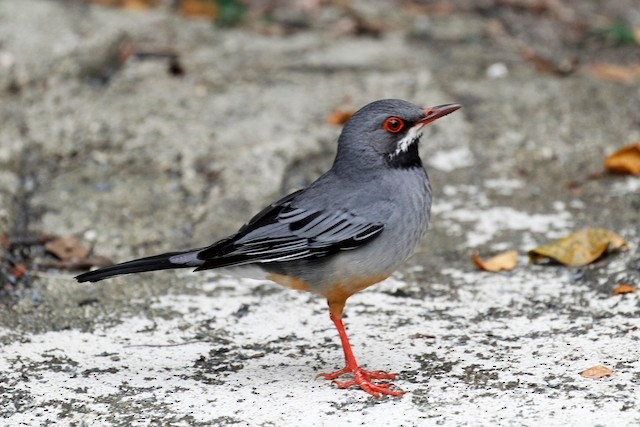Birdfinding.info ⇒ Generally common across most of Cuba, including Havana. Easy to find at all the heavily visited sites, including those in the western mountains of Pinar del Río and Artemisa, the Zapata Swamp area, Cayo Coco, and Topes de Collantes National Park. Also fairly easy to find throughout Cayman Brac.
Western Red-legged Thrush
Turdus rubripes
Endemic to Cuba, its satellites, and Cayman Brac, where it is widespread and common in most wooded habitats, including urban parks.
Identification
Slaty-gray overall, with black accents on the wings. White chin and whisker marks contrast with otherwise black throat.
Legs and eyering are bright red. The bill is mixed blackish and red; sometimes all-dark.
Uppertail mostly black, showing white outer feathers when spread. Undertail mostly white, including the vent.
Birds of western and central Cuba and Cayman Brac have a rusty belly. The eastern Cuban subspecies, schistaceus, typically has an all-gray belly—though some individuals show a faint rusty wash.
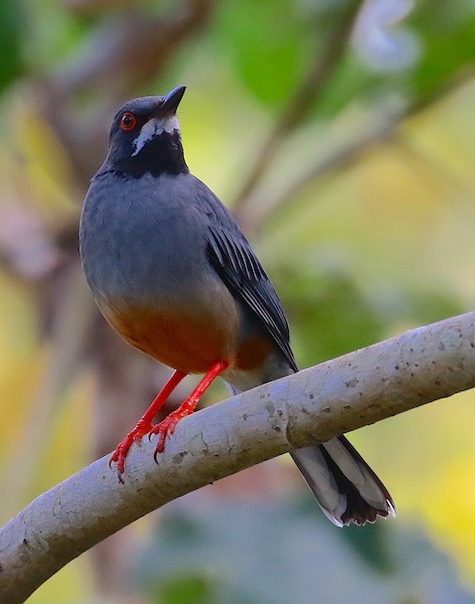
Western Red-legged Thrush, T. r. rubripes, showing the rusty belly typical of most populations. (Cueva de los Portales, Pinar del Río, Cuba; February 22, 2018.) © Arco Huang
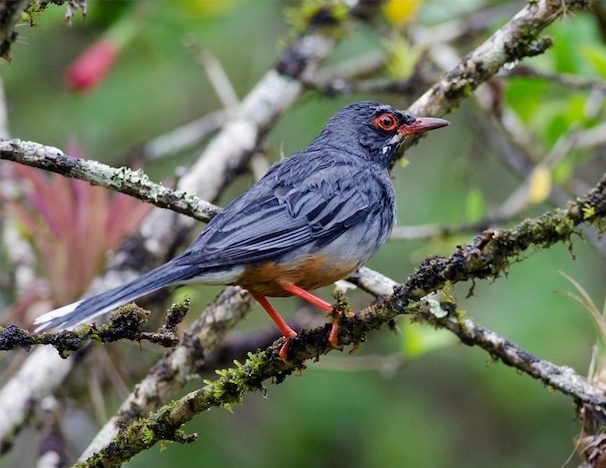
Western Red-legged Thrush, T. r. rubripes. (Topes de Collantes National Park, Cuba; February 18, 2015.) © Joshua D. Vandermeulen
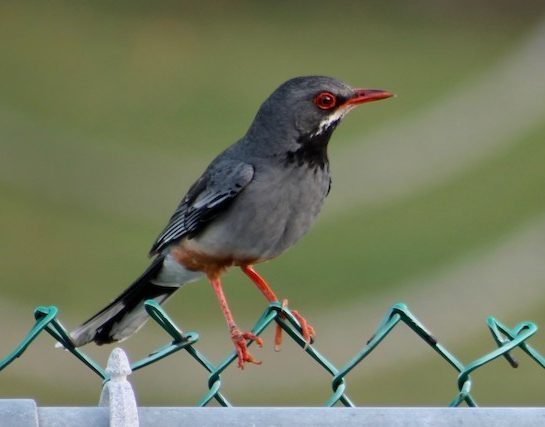
Western Red-legged Thrush, T. r. coryi. (West End Park, Cayman Brac; April 1, 2018.) © Holly Kleindienst
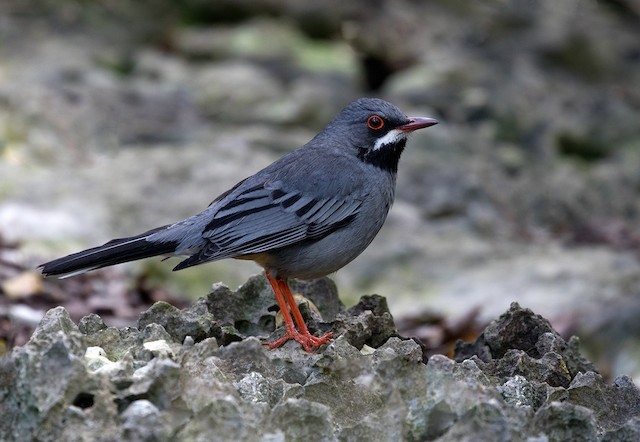
Western Red-legged Thrush, T. r. schistaceus. (Playa Pesquero, Holguín, Cuba; February 23, 2018.) © Suzanne Labbé

Western Red-legged Thrush, T. r. schistaceus, showing the all-gray belly typical of the eastern Cuban subspecies. (Playa Pesquero, Holguín, Cuba; February 19, 2018.) © Suzanne Labbé

Western Red-legged Thrush, T. r. rubripes. (Cueva del Jabali, Cayo Coco, Ciego de Ávila, Cuba; February 28, 2018.) © Arco Huang

Western Red-legged Thrush, T. r. rubripes. (Cueva del Jabali, Cayo Coco, Ciego de Ávila, Cuba; February 25, 2018.) © Christoph Moning
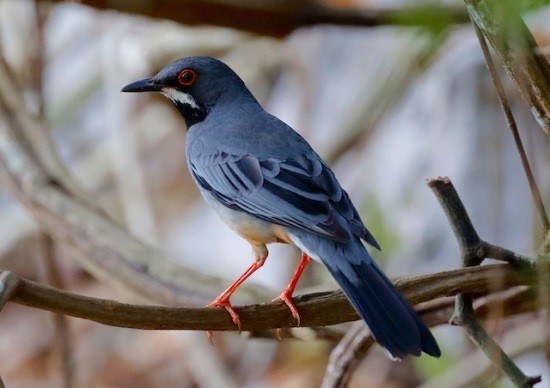
Western Red-legged Thrush, T. r. rubripes. (Cueva de la Vaca, Pinar del Río, Cuba; March 1, 2017.) © Timo Mitzen
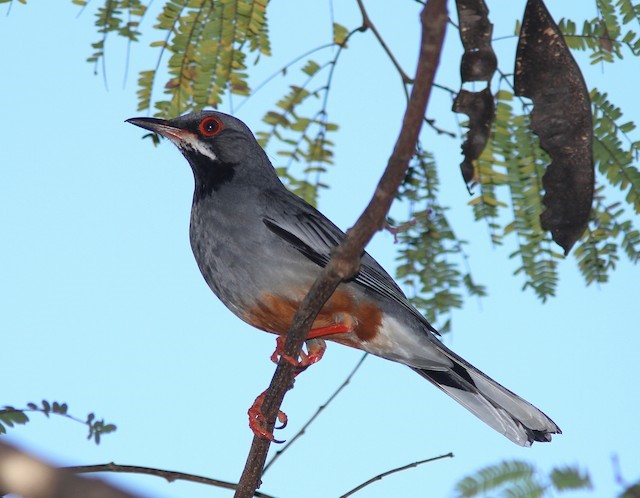
Western Red-legged Thrush, T. r. rubripes, showing rusty belly and mostly white undertail and vent. (El Cubano National Park, Cuba; January 2, 2014.) © Guy Poisson
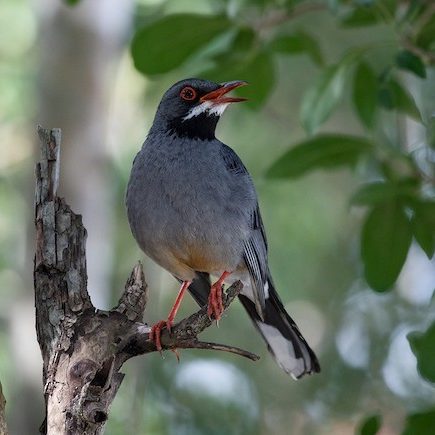
Western Red-legged Thrush, T. r. schistaceus, showing just a faint rusty wash on the belly. (Playa Pesquero, Holguín, Cuba; February 27, 2018.) © Suzanne Labbé

Western Red-legged Thrush, T. r. schistaceus, showing the all-gray belly typical of the eastern Cuban subspecies. (Guantánamo Bay, Cuba; February 2, 2018.) © Wayne Fidler
Voice. Song is an unhurried series of notes and brief phrases with a musical quality, lacking an obvious pattern:
Notes
Polytypic species consisting of three recognized subspecies, rubripes, schistaceus, and coryi.
Traditionally considered conspecific with Eastern and Northern Red-legged Thrushes, collectively the Red-legged Thrush (Turdus plumbeus).
References
del Hoyo, J., N. Collar, and J.S. Marks. 2019. Western Red-legged Thrush (Turdus rubripes). In Handbook of the Birds of the World Alive (J. del Hoyo, A. Elliott, J. Sargatal, D.A. Christie, and E. de Juana, eds.). Lynx Edicions, Barcelona. https://www.hbw.com/node/1344030. (Accessed January 27, 2019.)
eBird. 2019. eBird: An online database of bird distribution and abundance. Cornell Lab of Ornithology, Ithaca, N.Y. http://www.ebird.org. (Accessed January 27, 2019.)
Garrido, O.H, and A. Kirkconnell. 2000. Field Guide to the Birds of Cuba. Cornell University Press, Ithaca, N.Y.
Larsen, N. 2011. Red-legged Thrush (Turdus plumbeus), version 1.0. In Neotropical Birds Online (T.S. Schulenberg, ed.). Cornell Lab of Ornithology, Ithaca, New York. https://doi.org/10.2173/nb.relthr1.01.
Raffaele, H., J. Wiley, O. Garrido, A. Keith, and J. Raffaele. 1998. A Guide to the Birds of the West Indies. Princeton University Press, Princeton, N.J.
